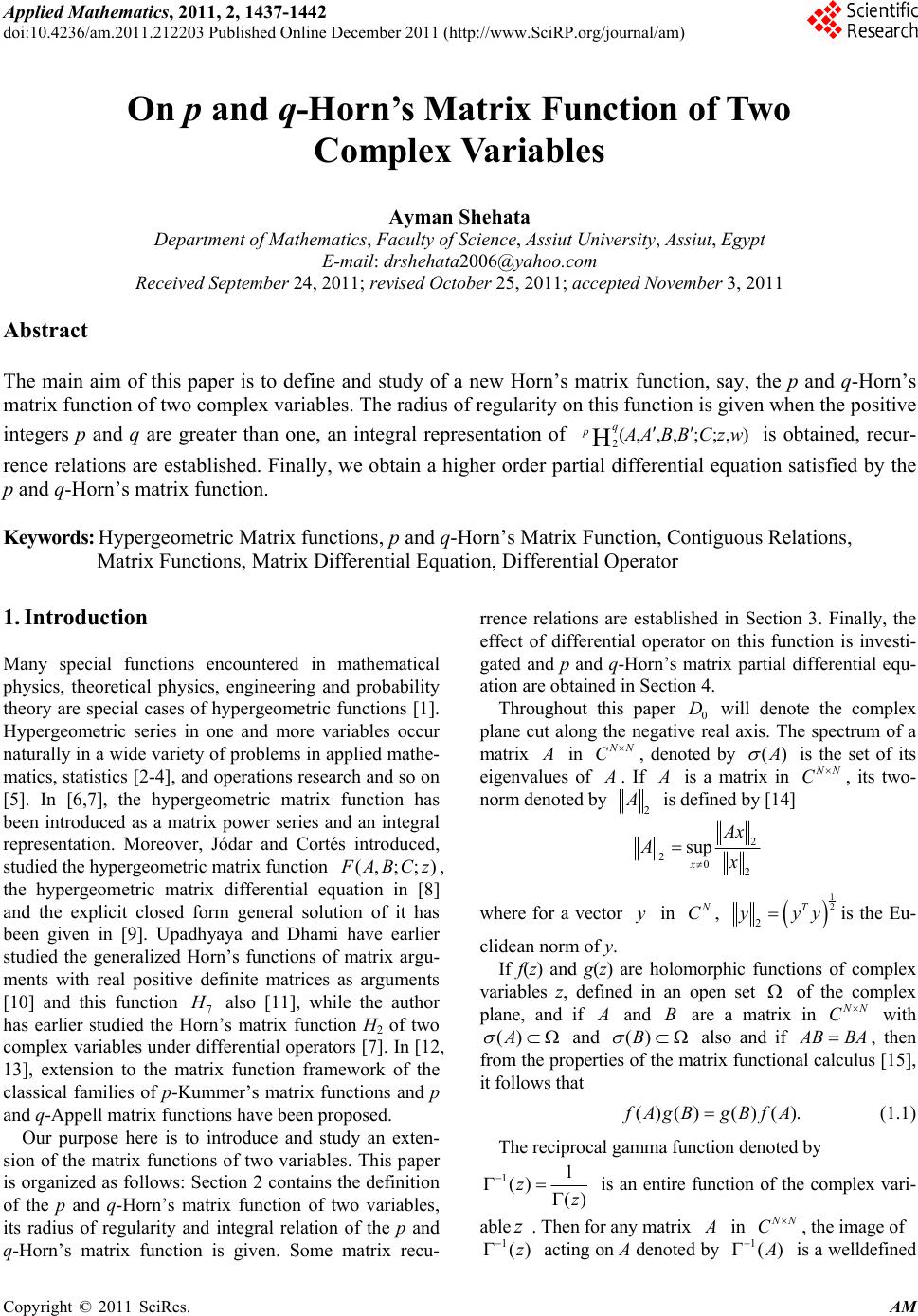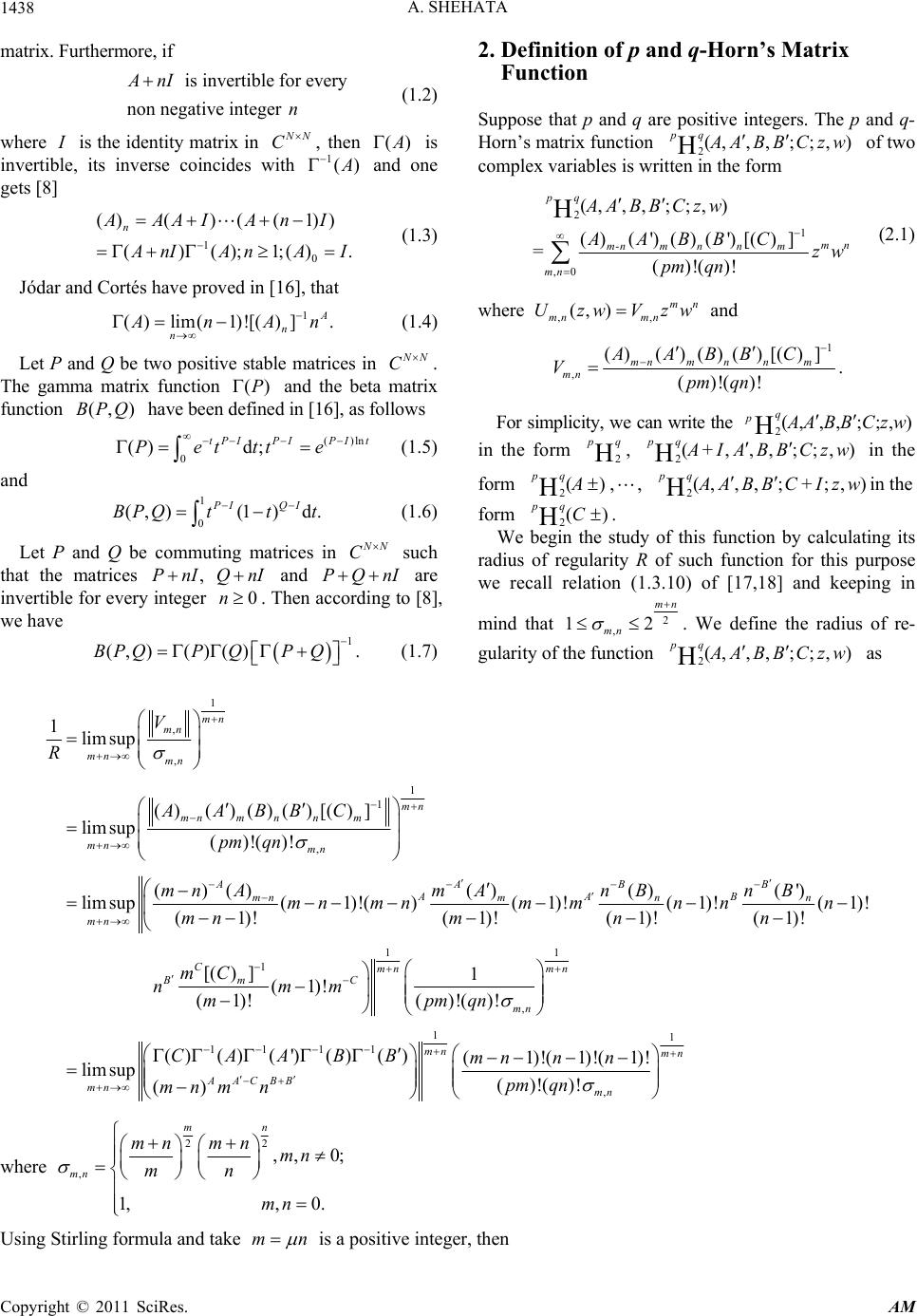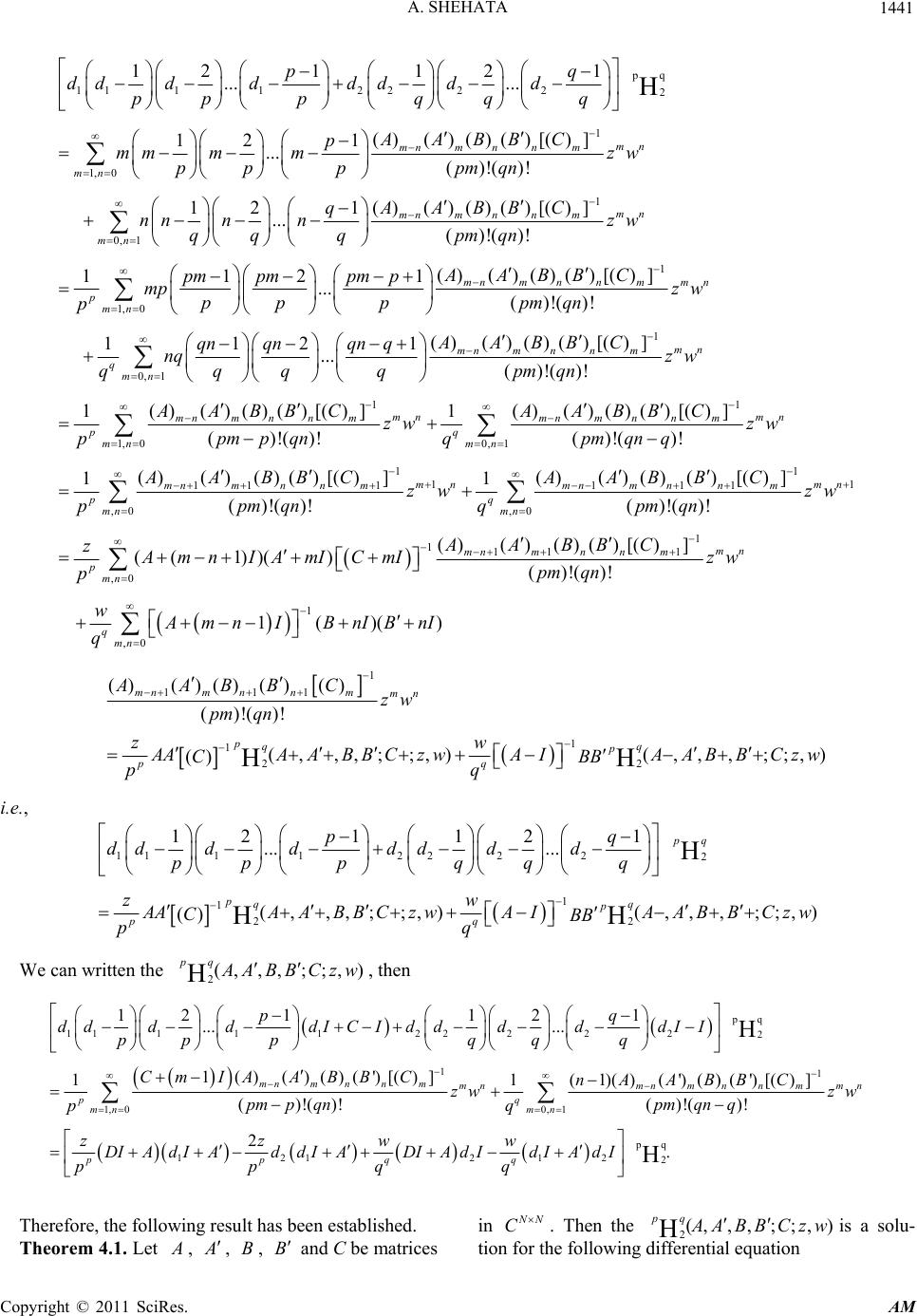 Applied Mathematics, 2011, 2, 1437-1442 doi:10.4236/am.2011.212203 Published Online December 2011 (http://www.SciRP.org/journal/am) Copyright © 2011 SciRes. AM On p and q-Horn’s Matrix Function of Two Complex Variables Ayman Shehata Department of Mat hematics, Fac ul t y of Sci ence, Assiut University, Assiut, Egypt E-mail: drshehata2006@yahoo.com Received September 24, 2011; revised October 25, 2011; accepted November 3, 2011 Abstract The main aim of this paper is to define and study of a new Horn’s matrix function, say, the p and q-Horn’s matrix function of two complex variables. The radius of regularity on this function is given when the positive integers p and q are greater than one, an integral representation of 2(,,,; ;,) Hq p ABBCzw is obtained, recur- rence relations are established. Finally, we obtain a higher order partial differential equation satisfied by the p and q-Horn’s matrix function. Keywords: Hypergeometric Matrix functions, p and q-Horn’s Matrix Function, Contiguous Relations, Matrix Functions, Matrix Differential Equation, Differential Operator 1. Introduction Many special functions encountered in mathematical physics, theoretical physics, engineering and probability theory are special cases of hypergeometric functions [1]. Hypergeometric series in one and more variables occur naturally in a wide variety of problems in applied mathe- matics, statistics [2-4], and operations research and so on [5]. In [6,7], the hypergeometric matrix function has been introduced as a matrix power series and an integral representation. Moreover, Jódar and Cortés introduced, studied the hypergeometric matrix function (,;;) ABCz , the hypergeometric matrix differential equation in [8] and the explicit closed form general solution of it has been given in [9]. Upadhyaya and Dhami have earlier studied the generalized Horn’s functions of matrix argu- ments with real positive definite matrices as arguments [10] and this function 7 also [11], while the author has earlier studied the Horn’s matrix function H2 of two complex variables under differential operators [7]. In [12, 13], extension to the matrix function framework of the classical families of p-Kummer’s matrix functions and p and q-Appell matrix functions have been proposed. Our purpose here is to introduce and study an exten- sion of the matrix functions of two variables. This paper is organized as follows: Section 2 contains the definition of the p and q-Horn’s matrix function of two variables, its radius of regularity and integral relation of the p and q-Horn’s matrix function is given. Some matrix recu- rrence relations are established in Section 3. Finally, the effect of differential operator on this function is investi- gated and p and q-Horn’s matrix partial differential equ- ation are obtained in Section 4. Throughout this paper 0 will denote the complex plane cut along the negative real axis. The spectrum of a matrix D in N C , denoted by () is the set of its eigenvalues of . If is a matrix in N C, its two- norm denoted by 2 is defined by [14] 2 202 sup x x A where for a vector in y C, 1 2 2 T yyyis the Eu- clidean norm of y. If f(z) and g(z) are holomorphic functions of complex variables z, defined in an open set of the complex plane, and if and are a matrix in B N C with ()A and ()B also and if BBA , then from the properties of the matrix functional calculus [15], it follows that ()() ()().fAgB gBfA (1.1) The reciprocal gamma function denoted by 11 () () zz is an entire function of the complex vari- able . Then for any matrix z in N C 1() , the image of acting on A denoted by 1 ()z is a welldefined  A. SHEHATA 1438 matrix. Furthermore, if is invertible for every non negative integer AnI n (1.2) where is the identity matrix in N C, then () is invertible, its inverse coincides with 1() and one gets [8] 1 0 ()() ((1)) ()();1;() n . AA IAnI nIA nAI (1.3) Jódar and Cortés have proved in [16], that 1 () lim(1)![()]. A n n nAn (1.4) Let P and Q be two positive stable matrices in N C . The gamma matrix function ()P and the beta matrix function have been defined in [16], as follows (, )BPQ ()ln 0 () d; tPIPIPI t Pettte (1.5) and 1 0 (, )(1)d. PI QI BPQtt t (1.6) Let P and Q be commuting matrices in N C such that the matrices and are invertible for every integer . Then according to [8], we have , PnIQnI 0nPQ nI 1 (, )()().BPQPQP Q 2. Definition of p and q-Horn’s Matrix Function Suppose that p and q are positive integers. The p and q- Horn’s matrix function2(,, ,; ;, ) H pq ABBCzw of two complex variables is written in the form 2 1 - ,0 (,, ,; ;, ) ()(')()(')[( )] =()!()! H pq mn mn mn nm mn AA BB Czw AABBC zw pm qn (2.1) where and ,, (, )mn mn mn UzwVzw 1 , ()( )()( )[()] ()!()! mnmnnm mn AABBC Vpm qn . For simplicity, we can write the 2(,,,; ;,) Hq p ABBCzw ,,;;,) in the form , 2 H pq 2(, H pq +IAB BCz w in the form 2() H pq , ,2(,, ,;;, ) H pq ABBC+Izw in the form 2() HC pq . We begin the study of this function by calculating its radius of regularity R of such function for this purpose we recall relation (1.3.10) of [17,18] and keeping in mind that 2 , 12 mn mn . We define the radius of re- gularity of the function2(,, ,; ;, ) H pq ABBCzw as (1.7) 1 , , 1 1 , 1lim sup ()()()()[()] lim sup()!()! ()()()()(') limsup(1)!()(1)!( 1)! (1)!(1)!( 1)! mn mn mn mn mn mnmnnm mn mn AAB AAB mnm n mn V R AABBC pm qn mnAmAn BnB mnmnm mn n mnm n B 11 1 , 11 11 11 , (1) (1)! [() ]1 (1)! (1)! ()!()! () () (') () ()(1)!( 1)!(1)! lim sup()!()! () n Cmn mn BC m mn mn mn AACBB mn mn n n mC nmm mpmqn CAABB mnnn pm qn mnm n ! where 22 , ,, 0; 1, ,0. mn mn mnmn mn mn mn Using Stirling formula and take mn is a positive integer, then Copyright © 2011 SciRes. AM  A. SHEHATA 1439 1 1(1) (1) 1 1 (1) 1(1) !(1) !(1) ! lim sup[(1)]()()!()! 1 2π(1) 2π (1)!( 1)!(1)! lim suplim sup ()!()! 2π n AACBB n n nn n pn nn nnnn nnn Rpnqn nn nn nnnn e pn qnpn pn e 1 2( 1)(1) 12 11 11 1 1 (1) 2π 11 lim sup0. nn qn qp qp n n ne qn qn e nn n nq p Summarizing, the following result has been established. As a conclusion, we get the following result. Theorem 2.1. Let , , , and be ma- trices in BBC N C such that CmI are invertible for all integer . Then, the p and q-Horn’s matrix function is an entire function in the case that, at least, one of the integers p and q are greater than one. 0m If , then the function is convergence in 1pq zr, ws and in [5,19]. (1)rs1 Integral form of the p and q-Horn Matrix Function Suppose that and are matrices in the space C N C of the square complex matrices, such that CCA , , and are positive stable ma- trices. CCA By (1.3), (1.4) and (1.7) one gets 1 11 1-- 11 (-1) 0 ()() ()( ) ()()1 d. mm CAI AmI AC AmICACmI CAC ttt (2.2) Substituting from (2.1) and (2.2), we see that 2 ,0 1 11 (1) 0 11 1- 0 3 0 (,,,;;,) () ()(') =()!()! ()()()(1 )d () ()() (,,;-;,) d. 1 H F pq mn mn nn mn Am ICAI pq CAI AI AA BB Czw ABB zw pm qn CAC ttt ACAC tABBztw t t Therefore, the following result has been established. Theorem 2.2. Let , , , and be ma- trices in BBC N C. Then the p and q-Horn’s matrix function of two complex variables satisfies the following integral form 2 11 1- 0 3 0 (,, ,; ;,) =(')( ')() (,,;-;, )d 1 H F pq pq CAI AI AA BB Czw ACAC tABB t ztwt (2.3) where 30 ,0 ()()() (,,;-;,) =() ()!()! F pq mn mn nn mn ABB BBztwztw pm qn . 3. Matrix Recurrence Relations Some recurrence relation are carried out on the p and q-Horn’s matrix function. In this connection the following contiguous functions relations follow, directly by increas- ing or decreasing one in original relation 2 1 ,0 1 ,0 1 1 , ,0 (A+) ()( ')()( ')[()] ()!()! (( )) ()()()()[()] ()!()! (()) (,) H pq mn mn mn nm mn mn mn mn nm mn mn AIAB BCzw pm qn AAmnI AIAB BC pm qn AAmnIUzw (3.1) and 1 2 ,0 1 , ,0 () ()()()[()] (A )()!()! ()[((1))]( ,). H pqmn mn mn nm mn mn mn AIAB BCzw pm qn AI A mnIUzw (3.2) Similarly Copyright © 2011 SciRes. AM  A. SHEHATA 1440 , 1 , 2 ,0 1 , 2 ,0 1 , 2 ,0 1 , 2 ,0 1 , 2 ,0 2 (+) (,), ()1 (,) (+)(, ), ()1 (,), (+) (,), () H H H H H H pq mn mn pq mn mn pqmn mn pq mn mn pqmn mn pq AAAmIUzw AI A mIUzw BBBnIUzw BBIBnIUzw BBBnIUzw B 1 , ,0 1 , 2 ,0 1 , 2 ,0 1( (C+)( ,), (C)1( ,). H H mn mn pqmn mn pq mn mn BI BnIUzw CCmIU zw CIC mIUzw ,), (3.3) 4. The p and q-Horn’s Matrix F u nction under the Differential Operator Consider the differential operator D on the p and q-Horn’s matrix function of two complex variables, defined in [7, 17] as 12 ,, 1 1, otherwise ddmn D where 1 dz z and 2 dw w . This operator has the property . () mn mn Dz wmnz w p q For the and -Horn’s matrix function the fol- lowing relations hold 2 ,0 1 2 22 () ()( )()()[()] ()!()! ()2 H HH pq mn mn mn mn n m qq p p DI A AmnI AABBC zw pm qn Ad A (4.1) and 12 1 - ,0 2 ()()()( )[()] ()!()! (). H H pq mn mnmnnm mn q p dI A AABBC mIz w pm qn A A (4.2) By the same way, we have 222 222 122 (), (), () () HH HH HH pqq p pqq p pqq p B dI BB BdI BB CdI C ICI . (4.3) From (4.1), (4.2) and (4.3), we get 2 22 2 22 2 22 2 22 ()2 (')(), ()2 (')(). HH H HH HH H HH pqq q p p qq pp pqq q p p qq pp A AA Bd A AB AB A AA Bd A AB AB (4.4) From (4.1), (4.3) and (4.4), we have 2 22 2 222 2 22 2 222 ()2 ()(), () ()2 ()( ) HH H HHH HH H HHH pqq q p p qqq ppp pqq q p p pqqq pp AABC d A CB CI B AAB Cd A CBCI B . 2 , H q (4.5) Also from (4.2), (4.3) and (4.4), we see that 2 22 22 2 2 22 22 2 ()() , ()( ) () () ()('). H HH HH H H HH HH H pq p qq pp pqq q pp pq p qq p qq q pp p AC ACCI A BBBB BB ACBB AC CI A BB BB (4.6) Now, we append this section by introducing the dif- ferential operator 1 dz z and 2 dw w to the en- tire functions in successive manner as follows; Copyright © 2011 SciRes. AM  A. SHEHATA Copyright © 2011 SciRes. AM 1441 pq 11112 2222 1 1, 0 0, 1 121 121 ... ... ()( )()( )[()] 12 1 ... ()!()! 1 H mn mn mn nm mn mn pq dd dddd dd pp pqq q AABBC p mm mmzw pp ppmqn nn q 1 1 1, 0 0, 1 ()( )()( )[()] 21 ... ()!()! () ()()()[()] 1121 ... ()!()! 112 . mn mnmnnm mn mn mn nm pmn qmn AABBC q nn zw qq pmqn AABBC pmpmpm p mpz w pp ppmqn p qn qn nq qq q 1 11 1,00, 1 11 ,0 ()( )()( )[()] 1 .. ()!()! ()( )()( )[()]()( )()( )[()] 11 ()!()! ()!()! ()( )() 1 mn mnmnnm mn mn mn mn nmmn mn nm pq mnm n mn m pmn AABBC qn qzw qpmqn AABBC AABBC zw zw pmpqnpmqn q pq AAB p 1 1 1 1 1111 ,0 1 111 1 ,0 ,0 ()[()]()()()()[()] 1 ()!()! ()!()! ()( )()( )[()] (( 1))()()!()! 1 mn mn nnmmn mn nm qmn mn mnmn nm pmn qmn BCAAB BC zw zw pm qnpm qn q AABBC zAmn IAmICmIzw pm qn p wAmn I q 1()( )BnIB nI 1 111 1 1 2 2 ()( )()( )() ()!()! (, ,,;;,)(,,, ;;, () HH mnm nnmmn pq q p pq AABBC zw pm qn zw) AAABBCzwAI AABBC CBB pq zw i.e., 11112 2222 1 1 2 2 121121 ... ... (, ,,;;,)(,,, ;;, () H HH pq pq q p pq pq dd dddddd pp pqq q zw) AAABBCzwAI AABBC CBB pq zw We can written the2(, ,,;;,) H pq ABBCzw , then pq 11111222222 1 1, 00, 1 12112 1 ... ... 1()()()(')[( )](1)()(')()( 11 ()!()! H mnm nnmmnmnm n p q mn mn pq dddddICI dddddII pp pqq q CmIAA BBCnAAB zw pm p qn pq 1 pq 121212 2 ') [()] ()!( )! 2. H mn nm ppqq BC zw pmqn q zzww DIAdIAddIADIAdI dIAdI ppqq Therefore, the following result has been established. Theorem 4.1. Let , , , and C be matrices in B B N C . Then the2(,, ,; ;, ) H pq ABBCzw is a solu- tion for the following differential equation  A. SHEHATA Copyright © 2011 SciRes. AM 1442 111112 2222 121212 2 12112 1 ... ... 2 ()()( ')()() 0. H pq ppqq pq dddddICI dddddII pp pqqq zzww DIAdIAddIADIAdI dIAdI ppqq (4.7) 5. Acknowledgements The Author expresses his sincere appreciation to Dr. M. S. Metwally, (Department of Mathematics, Faculty of Science (Suez), Suez Canal University, Egypt) for his kind interest, encouragements, help, suggestions, com- ments and the investigations for this series of papers. 6. References [1] H. M. Srivastava and P. W. Karlsson, “Multiple Gaussian Hypergeometric Series,” Ellis-Horwood, Chichester, 1985. [2] A. G. Constantine and R. J. Mairhead, “Partial Differen- tial Equations for Hypergeometric Functions of Two Ar- gument Matrices,” Journal of Multivariate Analysis, Vol. 2, No. 3, 1972, pp. 332-338. doi:10.1016/0047-259X(72)90020-6 [3] A. M. Mathai, “A Handbook of Generalized Spcial Func- tions for Statistical and Physical Sciences,” Oxford Uni- versity Press, Oxford, 1993. [4] A. M. Mathai, “Jacobians of Matrix Transformations and Functions of Matrix Argument,” World Scientific Pub- lishing, New York, 1997. [5] H. M. Srivastava and H. L. Manocha, “A Treatise on Ge- nerating Functions,” Ellis Horwood, New York, 1984. [6] M. T. Mohamed and A. Shehata, “A Study of Appell’s Matrix Functions of Two Complex Variables and Some Properties,” Journal Advances and Applications in Mathe- matical Sciences, Vol. 9, No. 1, 2011, pp. 23-33. [7] A. Shehata, “A Study of Some Special Functions and Polynomials of Complex Variables,” Ph.D. Thesis, Assiut University, Assiut, 2009. [8] L. Jódar and J. C. Cortés, “On the Hypergeometric Matrix Function,” Journal of Computational and Applied Mathe- matics, Vol. 99, No. 1-2, 1998, pp. 205-217. doi:10.1016/S0377-0427(98)00158-7 [9] L. Jódar and J. C. Cortés, “Closed form General Solution of the Hypergeometric Matrix Differential Equation,” Mathematical and Computer Modelling, Vol. 32, No. 9, 2000, pp. 1017-1028. doi:10.1016/S0895-7177(00)00187-4 [10] L. M. Upadhyaya and H. S. Dhami, “Generalized Horn’s Functions of Matrix Arguments,” Bulletin Pure and App- lied Sciences: Section E. Mathematics and Statistics, Vol. 29E, No. 2, 2010, pp. 353-364. [11] L. M. Upadhyaya, “A Summation Formula for a Horn’s Double Hypergeometric Function-II,” Bulletin Pure and Applied Sciences: Section E. Mathematics and Statistics, Vol. 2E, No. 2, 2010, pp. 279-286. [12] Z. M. G. Kishka, M. A. Saleem, S. Z. Radi and M. Abul- Dahab, “On the p and q-Appell Matrix Function,” South- east Asian Bulletin of Mathematics, Vol. 35, 2011, pp. 807-818. [13] M. S. Metwally, “On p-Kummers Matrix Function of Complex Variable under Differential Operators and Their Properties,” Southeast Asian Bulletin of Mathematics, Vol. 35, 2011, pp. 1-16. [14] G. Golub and C. F. Van Loan, “Matrix Computations,” The Johns Hopkins University Press, Baltimore, 1989. [15] N. Dunford and J. Schwartz, “Linear Operators, Part I,” Interscience, New York, 1955. [16] L. Jódar and J. C. Cortés, “Some Properties of Gamma and Beta Matrix Functions,” Applied Mathematics Letters, Vol. 11, No. 1, 1998, pp. 89-93. doi:10.1016/S0893-9659(97)00139-0 [17] K. A. M. Sayyed, “Basic Sets of Polynomials of Two Complex Variables and Convergence Properties,” Ph.D. Thesis, Assiut University, Assiut, 1975. [18] K. A. M. Sayyed, M. S. Metwally and M. T. Mohamed, “Certain Hypergeometric Matrix Function,” Scientiae Mathematicae Japonicae, Vol. 69, No. 3, 2009, pp. 315- 321. http://www.jams.or.jp/notice/scmjol/2009.html#2009-21 [19] A. Erdélyi, W. Magnus, F. Oberhettinger and G. Tricomi, “Higher Tanscendental Functions,” McGraw-Hill Book Co., New York, Vol. 1, 1953.
|